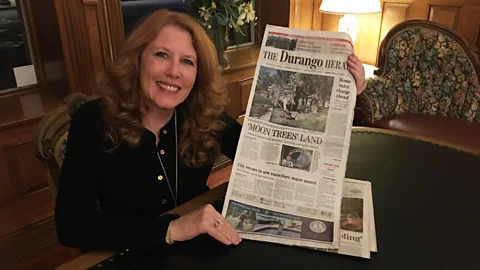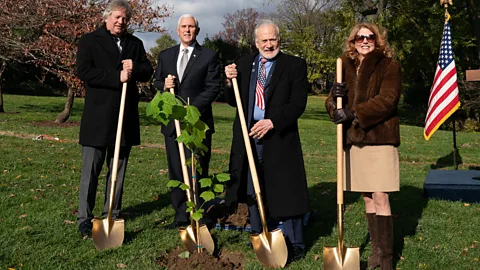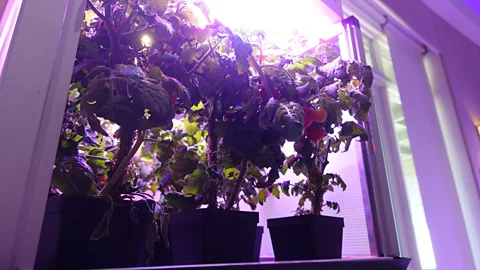The trees grown from space-faring seeds
 Nasa
NasaOne of the last Apollo missions to the Moon carried seeds that were later returned to be planted back on Earth. But where many of these space-faring plants ended up is a mystery, and now the hunt is on to track them down.
In a grey plastic plant pot on a windowsill somewhere in southern England, Royal Astronomical Society (RAS) administrator Richard O'Sullivan is attempting to grow an American sycamore tree.
As anyone who's ever successfully nurtured a plant from seed knows, this is an achievement in itself. But this is no ordinary sycamore sapling. Its provenance can be traced back to a mission to the Moon in 1971, when astronaut Stuart Roosa carried 500 tree seeds in his Apollo 14 spacecraft. Trees grown from these seeds became known as "Moon Trees". Assuming the plant continues to flourish, O'Sullivan's will be a rare third-generation Moon Tree.
"Forty seeds were collected from a mature second-generation tree growing in a private garden in central England," explains O'Sullivan, who volunteered for the project as part of the Royal Astronomical Society's 200th anniversary celebrations. "But only three of those seeds germinated and I've got one of them – so the pressure is on a bit."
The idea of carrying tree seeds to the Moon has its origins in Roosa's early career in the 1950s working for the United States Forest Service. Like many of the early astronauts, Roosa was a real-life action hero. Before training as a military jet pilot, he took on what is arguably an even more dangerous job as a smoke jumper.
"Smoke jumpers would parachute into a forest fire, build a trench and do what they could to mitigate the fire before hiking out to the nearest forestry camp – it was pretty harrowing," says Roosa's daughter, Rosemary. "My father loved nature, but I also think it got him around airplanes because he knew, from a young boy, that he wanted to be a pilot."
You might also like:
After proving himself as a skilled fighter pilot and, later, a test pilot in the US Air Force, Roosa was selected as an astronaut in 1966. His first spaceflight would be as command module pilot for Apollo 14. This meant he would remain in orbit alone around the Moon, while his two colleagues travelled down to the lunar surface.
 Universal History Archive/Getty Images
Universal History Archive/Getty ImagesRoosa was handpicked for the mission by his commander, Alan Shepard – who had been the first American in space.
"My father was an excellent stick-and-rudder man, as they would call him. He was just a really good pilot, had great instincts," says Roosa. "It was a bit of a controversy at the time because my father was the only astronaut to be selected for a prime crew having never served on a back-up crew, but Alan Shepard later said because the command module pilot gets the astronauts to the Moon and back, he wanted to make sure he got home!"
While Roosa began training for his mission, the Forest Service approached the astronaut to ask if he would carry some seeds to the Moon among his personal items. He readily agreed and a Forest Service geneticist chose a selection of five species: Douglas fir, loblolly pine, redwood, sycamore, and sweetgum.
It would be easy to dismiss the project as just a publicity stunt, but it was rooted in science. How would a trip around the Moon effect the seeds' health, viability, and long-term genetics? This would be the first time seeds had been sent into deep space, a progression from previous experiments.
"We have been sending seeds into space since before Nasa was founded," says Emma Doughty, host of the Gardeners of the Galaxy podcast. "When America was firing captured German V2 rockets in the 1940s, they were sending seeds into space alongside other sorts of organisms, such as insects, to test how the space environment and radiation affected lifeforms.
"We knew nothing about what would happen to life when it left the atmosphere or what happened in microgravity," she says. "We needed to know if life could survive up there before we started sending anything that anybody was going to care about."
On 31 January 1971, the crew of Apollo 14 – Shepard, Roosa and lunar lander pilot Ed Mitchell – blasted-off from Cape Canaveral on their giant Saturn V rocket towards the Moon. After the near disaster of Apollo 13, Nasa was under enormous political pressure to ensure this mission went without a hitch. But three hours into the flight, they were already in trouble.
 Rosemary Roosa
Rosemary RoosaFor launch, the lunar lander was encased in the upper stage of the Saturn V, behind the module carrying the crew. It was Roosa's job to separate the command and service module, spin around 180 degrees and dock with the lander.
To begin with, the manoeuvre went to plan and Roosa perfectly aligned the probe at the tip of the command module with the hatch on the lander. But when the two spacecraft were pushed together, the latching mechanism failed to engage. With the crew getting increasingly concerned about the very real possibility of the mission being aborted. It wasn't until the sixth attempt, nearly two hours later, that the latches finally locked to achieve a "hard dock". (You can read Nasa's original report into the problem here.)
The rest of the mission was near faultless. Shepard – himself a legendary pilot – made the most precise landing on the Moon yet, and he and Mitchell set new duration and distance records on the lunar surface. During two traverses, the astronauts collected some 43kg (95lb) of rocks and soil. Shepard even had time for a quick round of golf.
Meanwhile, Roosa (and the seeds) spent two days orbiting in the command module – maintaining spacecraft systems, carrying out experiments and taking photographs and observations of the lunar surface. He became one of only six men to be completely alone in deep space (an experience the late Apollo 15 astronaut Al Worden talked about in this interview).
On 9 February 1971, the Apollo 14 crew returned to Earth as heroes and the Moon landing programme was back on track. Most of the seeds, meanwhile, were returned to the Forest Service, although Roosa and Mitchell kept a few. But this is where the story starts to become a little vague. Despite this supposedly being a scientific experiment led by two respected US government organisations, no-one at the time kept accurate records of where exactly the seeds ended up or where the Moon Trees grown from them were planted.
 Rosemary Roosa
Rosemary Roosa"The Forest Service started dispersing them, mostly during the bicentennial of the United States in 1976, and so they were given as gifts," says Rosemary Roosa. "When I come across original Moon Trees, many of them are planted in state capitals, botanical gardens and parks but there was no formal documentation that I'm aware of."
Some were also sent abroad, although exactly where is unclear. There are known to be three in Brazil, possibly one in France and there was a claim that between 12 and 15 first-generation Moon Trees were planted in the UK. The Royal Astronomical Society has spent the last year trying to track them down, without success.
"The last Moon Tree that I know of, my father and I planted in Austin, Texas, at the end of the 70s," Roosa says (it was planted at her childhood home). "I was in the backyard and he said, 'Hey, this is the last of the Moon Tree seeds that I have, let's plant it and see what happens'. It was American sycamore and I've talked to the owner of the home and it's still growing."
Stuart Roosa passed away in 1994 and Rosemary set up the Moon Tree Foundation to keep his legacy alive. Nasa, through the efforts of planetary scientist Dave Williams, has also been trying to keep track of the trees and has published a list of more than 60 first-generation plants that are still alive. Most appear to be in the US, though it appears those sent to Brazil are still thriving.
Since Apollo 14 there have been dozens of similar – albeit more scientifically rigorous – experiments involving sending seeds and plants into space. Today, astronauts on the International Space Station (ISS) regularly eat salad grown on board. In 2016, 2kg (4.4lb) of rocket seeds went to the ISS with British astronaut Tim Peake. The RAS's research into the seeds said "results showed that, while the rocket seeds grew more slowly and were more sensitive to ageing, they were still viable".
Future long-duration exploration of the Moon and Mars depends on being able to grow fresh food in deep space. The fact that so many Moon Trees are thriving, and producing viable offspring, suggests the seeds Roosa carried in Apollo 14 suffered few ill-effects.
 Kerry Sheridan/AFP/Getty Images
Kerry Sheridan/AFP/Getty ImagesThis year marks the 50th anniversary of the final Apollo mission, Apollo 17, and less than half the Apollo astronauts are still alive. But their legacy lives on… in trees.
"It was an amazing thing to do," says Doughty. "I think that is the legacy of the Moon Trees: to get people interested in space. If they can see something that's been to space growing in their local park, it very much brings it down to Earth and makes it real for people."
And, as Nasa prepares to return to the Moon and eventually set up a lunar base, Rosemary Roosa has an ambitious plan.
"My goal is to have Moon Tree seeds sent back to the Moon and planted there – then they definitely would be Moon Trees."
If you know of any Moon Trees in the UK or outside the United States, let us know via the BBC Future Facebook page and we'll pass on the information to the Royal Astronomical Society and the Moon Trees Foundation.
--
